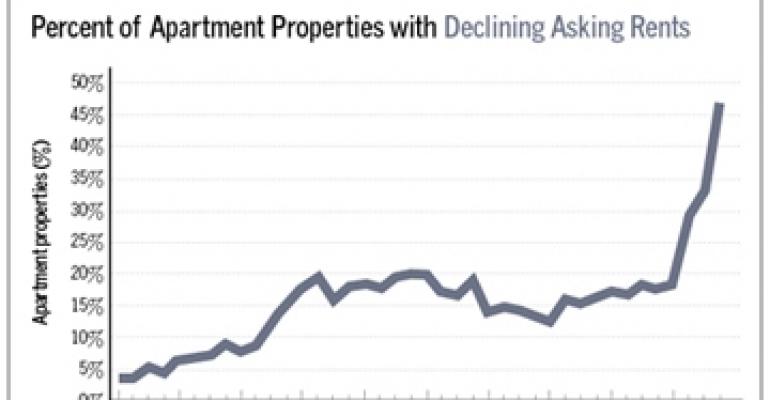
The deterioration in apartment asking rents reached unprecedented levels in the fourth quarter of 2008. Almost half of multifamily properties in the U.S., or 48.6%, reported declines, according to New York-based research firm Reis. If the rise in concessions were factored in, the percentage of properties decreasing rents would be well over 60%.
“You’ve got a high vacancy rate of single family homes. If the owner still owns it and it hasn’t been foreclosed, they’re renting it out,” says Victor Calanog, director of research for Reis. “You’ve got competitive property types like condos in South Florida. It’s the shadow inventory story. You’ve got an overall weakness in demand, plus the fact that there’s shadow inventory fighting with standard multifamily property now that’s really putting a lot of pressure on landlords.”
Out of the 79 markets tracked by Reis, 58 are showing negative rent growth spread fairly evenly across property classes. For the fourth quarter, the top three markets with the largest effective rent growth declines are New York at 1.9%; Miami with a decline of 1.8%; and San Bernardino, Calif., down 1.4%.
Looking at the nation as a whole, the overall magnitude of rent declines may seem modest. In the fourth quarter of 2008, effective rents declined 0.4%. For 2009, Reis projects a negative 1.7% decline in multifamily effective rents, a number that has never before been observed by the research firm.
Aside from the weakening economy and shadow space darkening the apartment sector, the rapid and extreme fall in asking rents is also tied to the vacancy rate. “In the previous business cycle, this sector really ended the upswing very strong and very tight. It ended the year 2000 at a 3.2% vacancy rate. Reis didn’t actually record a decline in asking rents until well into 2002,” says Calanog. “Asking rents really began tanking in 2002 and it’s not a coincidence that that was when vacancies also broke 6%. Now we’re starting the decline at 6.6% vacancy.”
In this current business cycle, Calanog explains, vacancy rates bottomed out at 5.5% in the third quarter of 2006 and have been creeping upward ever since. “So there was already some weakness evident in early 2008 but then everything came to a head in the fourth quarter and suddenly apartment landlords were faced with a 6%-plus vacancy rate at the beginning of the downswing,” he says.
In the last downturn, the vacancy moved from a low of 3.2% in 2000 to a high of 7.2% in the first quarter of 2004, an increase of 400 basis points. On a more optimistic note, however, from the end of 2008 to end of 2009, Reis is only forecasting an increase of 80 basis points, from 6.6% to 7.4%.
Based on information gathered on the ground, Calanog says that brokers prescribe one of two ways for landlords to lower rents. First, landlords are offering tenants a long-term lease of say, two years. That provides security and income for two years, especially appealing if rents continue to fall. Second, landlords also have become more amenable to short-term leases of three to six months, he says, “because a short income for three to six months is better than nothing.”

